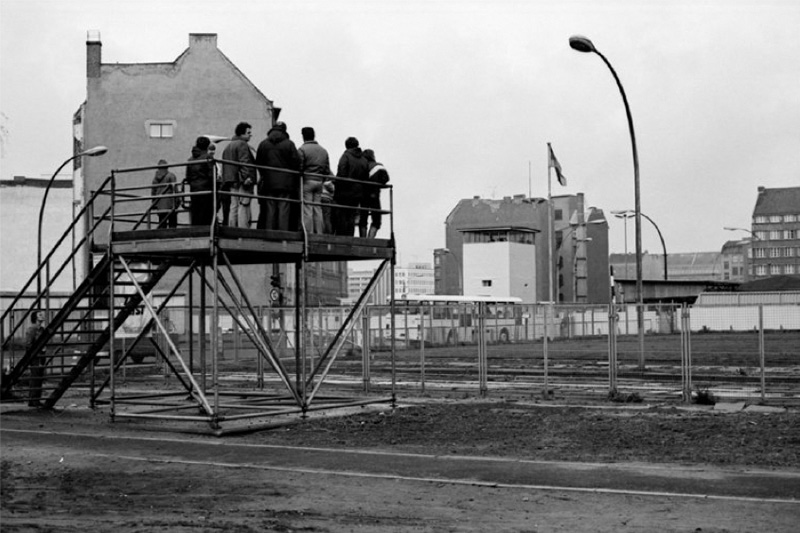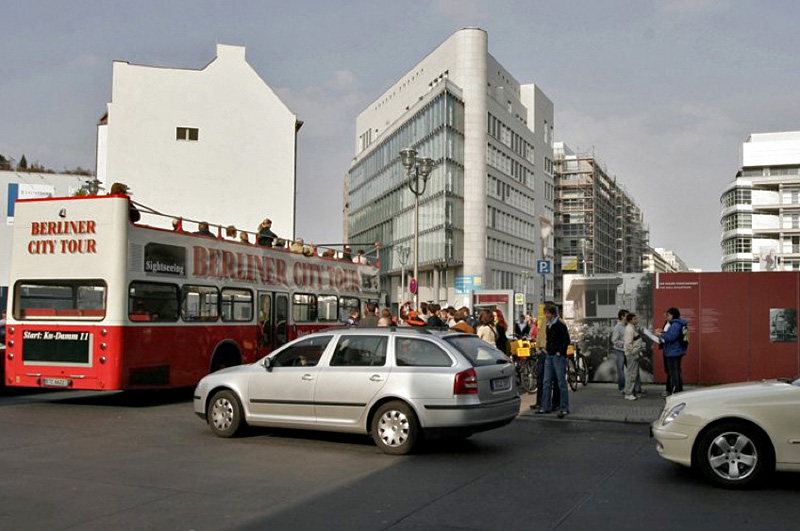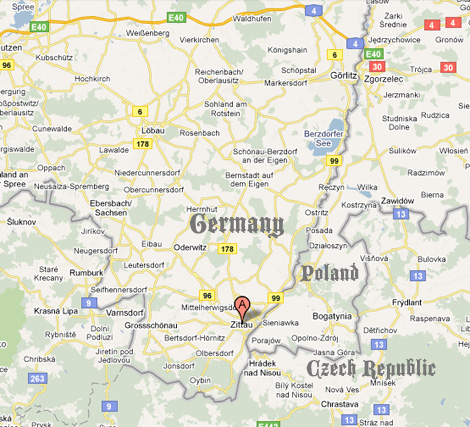 Checkpoint Charlie, 1982: The famous border crossing Checkpoint Charlie
on Friedrichstrasse in downtown Berlin. The border crossing was meant
only for foreigners who wished to travel from East to West Berlin or
vice versa.
Checkpoint Charlie, 1982: The famous border crossing Checkpoint Charlie
on Friedrichstrasse in downtown Berlin. The border crossing was meant
only for foreigners who wished to travel from East to West Berlin or
vice versa.
 Checkpoint Charlie, 2007: The former border crossing is now a popular
tourist destination: Complete with vendors selling East German
paraphernalia and renting out East German "Trabant" cars.
Checkpoint Charlie, 2007: The former border crossing is now a popular
tourist destination: Complete with vendors selling East German
paraphernalia and renting out East German "Trabant" cars.
Photos by Jürgen Ritter (spiegelonline captions)
I've always thought borders were strange places because it's a strange idea—an arbitrary line through the landscape where one "place" supposedly ends and another supposedly begins. They makes sense on maps and in our heads, but maybe not so much at the actual location where they're said to exist. The exception, of course, is when people take them very seriously, like the DMZ between North and South Korea. At those places, our conceptual world exercises its literal hold over our freedom to move about.
An interesting photo essay was published in Spiegel Online recently showing "The East-West German Border, Then and Now." The pictures show places which used to be an important conceptual demarcation but have now gone back to being merely places.
Mike
(Thanks to Cal Amari)
Send this post to a friend
Featured Comment by mcananeya: "Hooo boy! If you want to talk about borders as a strange idea and arbitrary lines, then I’m your man!
I briefly lived in Zittau, Germany, which is located in what is called the 'Dreiländereck' in German (i.e., the 'three-country corner' that is the border between Poland, the Czech Republic, and Germany). The only problem being that it isn’t much of a corner and the three countries don’t meet in neat, straight lines.* There is a little tongue of Poland that extends further south than the rest of Poland and separates the main area of Zittau from the Czech Republic. There is no good way to describe this in words, so take a look at this map to get a sense of what I’m talking about.

"To get from Zittau, Germany to Hradek nad Nisou, Czech Republic by car, you needed to drive across this strip of Poland which is roughly a mile wide at the relevant point. As you left Zittau , you would first reach the German border control checkpoint. All of the people in the car would hand their passports (or national identity cards) to the driver, who would hand them to the German border control officer. He would walk off to his little hut, review the documents, stamp the passports, etc. then walk back to your car and hand everything to the driver. The gate would go up and the car would roll forward about 30 yards to the Polish border control checkpoint. The driver would hand all of the passports and ID cards to the Polish border control officer. He would walk off to his little hut, review the documents, stamp the passports, etc. then walk back to your car and hand everything to the driver. The gate would go up and you were officially in Poland! (For the next minute or two, that is.) You would then drive along a two-lane road lined on the left and the right with a) gas stations (gas was cheaper in Poland than in Germany, primarily due to lower taxes), b) shops selling cigarettes (cigarettes were cheaper in Poland than in Germany, primarily due to lower taxes) and c) stands selling garden gnomes in every form and color imaginable (because…because…well, actually, I never came up with a good reason for this). You would then roll up to…the Polish border control checkpoint, which was practically in view of the border control checkpoint you just left, hand your documents to the Polish border control officer, wait for him to review, roll forward 30 yards to the Czech border control checkpoint, have them review, etc., until finally the gate went up and you were now in the Czech Republic. After doing some shopping and having a beer, you now got back into your car and went through the whole procedure again to return to Zittau, Germany.**
"Madness. This was a fluid border and people went back and forth across it all the time, sometimes even several times a day!
"One day I expressed my amazement at this procedure to a friend of mine who gave me an odd look and asked why I didn’t just walk or bike across the border. It turns out that there was a well-known path through the woods that led directly from Zittau to Hradek. If you went by this path, you (a) went by a shorter route than the detour through Poland, and (b) didn’t have to deal with border formalities, since the checkpoint in the woods (a 1m x 1m wooden box) had been abandoned years ago! So go by car, and you go through three countries and four checkpoints and get to browse for garden gnomes, but go by foot and you go for a nice walk in nature. Makes sense to me....
"I have no idea whether any of this has changed since Poland and the Czech Republic joined the EU.
"Finally, while I was in Zittau I also occasionally taught in a nearby town which was even more bizarre from a border perspective, since the German/Polish border literally goes through the center of town! The German side is known at Görlitz, whereas the Polish side is known at Zgorzelec—same name, different spelling."
*Of course, I am sure that borders that are straight lines are generally indicative of the fact that an even more random and arbitrary border has been drawn, presumably by men poring over a map and smoking fat cigars while determining the fates of thousands of people with their rulers…
**For anyone interested in collecting stamps in their passport, this was heaven. On the other hand, these weren’t the kind of stamps that were likely to induce jealousy among friends.
Mike replies: Wow. And what's the deal with Neusatza-Spremberg? I also like the lake named Spree....
Featured Comment by Eric: "Where I live in Holland, if I need to fill up, I drive five minutes down the (Dutch) road before turning left into a German gas station. Gas is cheaper in Germany."
Featured Comment by Vladimir Riha: "Hradek nad Nisou is where I grew up (I live in Sydney now) and I often visit my family there. The border procedure was exactly like it's described above. Since Poland and Czech Republic entered into Shangan group you just drive through without any problems or stopping. Our house is less than 1 km from the spot where three countries meet. When there I often would bike ride from Czech Republic to Germany to Poland and back to Czech Republic before breakfast. Nice part of the world."





